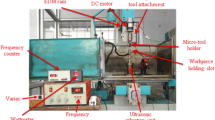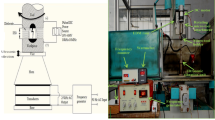Abstract
Making miniature holes of acceptable tolerances in titanium alloys by conventional drilling is difficult due to frequent tool failure because of its poor thermal conductivity, high hardness, and high chemical affinity with cutting tool materials. Micro-electrical discharge machining (micro-EDM) has been found as a suitable method of machining of miniature holes in titanium alloys but it faces some problems such as improper flushing of the debris, arcing, short-circuiting, frequent adhesion of tool electrode with workpiece, and poor machining rate. To overcome all these problems, authors have developed a new ultrasonic-assisted micro-EDM setup and fitted to already available ZNC-EDM machine. The objective of the present work is to study experimentally the effect of gap current (I g), pulse on-time (T on), pulse off-time (T off), and ultrasonic power (U P) on material removal rate (MRR), tool wear rate (TWR), and hole taper (T a) due to ultrasonic-assisted hole sinking micro-EDM (UA-HS-MEDM) in titanium alloy workpiece. Experimental results reveal that introduction of ultrasonic vibration in hole sinking micro-EDM (HS-MEDM) has significant effect on MRR, TWR, and T a. A comparative observation regarding recast layer and circularity of microholes made by HS-MEDM with and without ultrasonic vibration has also been reported.
Similar content being viewed by others
References
Ezugwu EO (2005) Key improvements in the machining of difficult-to-cut aerospace superalloys. Int J Mach Tool Manu 45:1353–1367
Machado AR, Walbank J (1990) Machining of titanium and its alloys—a review. Proc IMechE Part B: J Eng Manuf 204:53–60
Jain VK (2010) Introduction to micromachining. Narosa Publishing House Pvt. Ltd, New Delhi
Tiwary AP, Pradhan BB, Bhattacharyya B (2014) Study on the influence of micro-EDM process parameters during machining of Ti–6Al–4V superalloy. Int J Adv Manuf Technol 76:151–160
Yeo SH, Tan LK (1999) Effects of ultrasonic vibrations in micro electro-discharge machining of microholes. J Micromech Microeng 9:345–352
Hung JC, Lin JK, Yan BH, Liu HS, Ho PH (2006) Using a helical micro-tool in micro-EDM combined with ultrasonic vibration for micro-hole machining. J Micromech Microeng 16:2705–2713
Teimouri R, Baseri H (2013) Experimental study of rotary magnetic field-assisted dry EDM with ultrasonic vibration of workpiece. Int J Adv Manuf Technol 67:1371–1384
Murali MS, Ganesh BP, Kamlakar PR (2008) A study on process parameters of ultrasonic assisted micro EDM based on Taguchi method. J Mater Eng Perform 17:210–215
Kremer D, Lebrun JL, Hosari B, Moisan A (1989) Effects of ultrasonic vibrations on the performance in EDM. Annals of the CIRP 38(1):199–202
Wansheng Z, Zhenlong W, Shichun D, Guanxin C, Hongyu W (2002) Ultrasonic and electric discharge machining to deep and small hole on titanium alloy. J Mater Proc Technol 120:101–106
Huang H, Zhang H, Zhou L, Zheng HY (2003) Ultrasonic vibration assisted electro-discharge machining of microholes in Nitinol. J Micromech Microeng 13:693–700
Gao C, Liu Z (2003) A study of ultrasonically aided micro-electrical-discharge machining by the application of workpiece vibration. J Mater Process Technol 139:226–228
Kim DJ, Yi SM, Lee YS, Chu CN (2006) Straight hole micro EDM with a cylindrical tool using a variable capacitance method accompanied by ultrasonic vibration. J Micromech Microeng 16:1092–1097
Tong H, Li Y, Wang Y (2008) Experimental research on vibration assisted EDM of micro-structures with non-circular cross-section. J Mater Process Technol 208:289–298
Endo T, Tsujimoto T, Mitsui K (2008) Study of vibration-assisted micro-EDM—the effect of vibration on machining time and stability of discharge. Precis Eng 32:269–277
Jahan MP, Wong YS, Rahman M (2012) Evaluation of the effectiveness of low frequency workpiece vibration in deep-hole micro-EDM drilling of tungsten carbide. J Mater Process Technol 14:343–359
Prihandana GS, Mahardika M, Hamdi M, Wong YS, Miki N, Mitsui K (2013) Study of workpiece vibration in powder-suspended dielectric fluid in micro-EDM processes. Int J Precis Eng Manuf 14(10):1817–1822
Mahardika M, Prihandana GS, Endo T, Tsujimoto T, Matsumoto N, Arifvianto B, Mitsui K (2012) The parameters evaluation and optimization of polycrystalline diamond micro-electro-discharge machining assisted by electrode tool vibration. Int J Adv Manuf Technol 60:985–993
Lee PA, Kim Y, Kim BH (2015) Effect of low frequency vibration on micro EDM drilling. Int J Precis Eng Manuf 16(13):2617–2622
Montgomery DC (2014) Design and analysis of experiments. Wiley, New York
Sohani MS, Gaitonde VN, Siddeswarappa DAS (2009) Investigation into the effect of tool shapes with size factor consideration in sink electrical discharge machining (EDM) process. Int J Adv Manuf Technol 45:1131–1145
Khan AA (2008) Electrode wear and material removal rate during EDM of aluminum and mild steel using copper and brass electrode. Int J Adv Manuf Technol 39:482–487
Singh S, Maheshwari S, Pandey PC (2004) Some investigations into the electrical discharge machining of hardened tool steel using different electrode materials. J Mater Process Technol 149:272–277
Khara AK, Sarkar BR, Bhattacharya B, Patahk LC, Godkhindi MM (2007) Performance of ZrB2-Cu composite as an EDM electrode. J Mater Process Technol 183:122–126
Chen SL, Lin MH, Hsieh SF, Chiou SY (2008) The characteristics of cutting pipe mechanism with multi-electrode in EDM. J Mater Process Technol 203:461–464
Kibria G, Sarkar BR, Pradhan BB, Bhattacharyya (2010) Comparative study of different dielectrics for micro-EDM performance during microhole machining of Ti-6Al-4V alloy. Int J Adv Manuf Technol 48:557–570
Vaibhav YG, Nitin GP, Sudhir DD (2016) Comparison of insulated electrode in micro hole drilling to avoid secondary discharge. Proceedings of 6th International & 27th All India Manufacturing Technology, Design and Research Conference (AIMTDR-2016). COEP Pune, 147–149
Author information
Authors and Affiliations
Corresponding author
Rights and permissions
About this article
Cite this article
Singh, P., Yadava, V. & Narayan, A. Parametric study of ultrasonic-assisted hole sinking micro-EDM of titanium alloy. Int J Adv Manuf Technol 94, 2551–2562 (2018). https://doi.org/10.1007/s00170-017-1051-1
Received:
Accepted:
Published:
Issue Date:
DOI: https://doi.org/10.1007/s00170-017-1051-1




